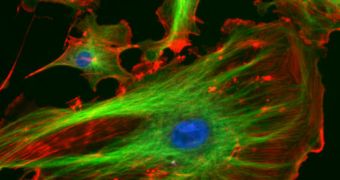The intricate processes behind newborns developing an immune system have been exposed for the first time by scientists at the California Institute of Technology. Using gold atoms to track down proteins inside the new body, they uncovered that the antibodies transmitted by the mother through breast milk or through the placenta during pregnancy are literally snatched by a protein in cells inside the intestines and then delivered into the bloodstream.
The neonatal Fc receptor (FcRn) protein is primarily responsible for trapping the antibodies circulating inside an infant's gut. It then surrounds them with a protective layer, called a vesicle, and breaks off from its original position, delivering the antibodies to the other end of the cell, where all of the blood vessels are located. Then, the vesicle, containing both the protein and the antibody binds to the cellular wall and simply delivers the much-needed antibody into the bloodstream.
By using a newly-devised process called electron tomography, Pamela Bjorkman, professor of biology at Caltech and researcher at Howard Hughes Medical Institute, was able to photograph the protein binding to the antibodies. In electron tomography, several low exposure time pictures of tiny objects are recorded at variable positions around it. A sophisticated computer is then able to piece the pictures together and create a virtual 3D model of the object, in this case the antibody and the protein.
The technique is very similar to the one used by CT scans, were multiple X-rays are combined to form a 3D image of the patient's brain. "You can get an idea of movement in a series of static images by taking them at different time points," Bjorkman said. As a result of using this procedure, Caltech scientists were able to determine that multivesicular bodies, containing several cells with regular vesicles inside, actually played a role in the transmission of antibodies, whereas they were previously thought to just aid with collecting refusals from regular cells.
The Caltech team now strives to find out exactly how the proteins in our immune system recognize their specific "targets" and only bind with them and not other enzymes or pieces of cells. "The process of receptor-mediated transport is fundamental to many biological processes, including detection of developmental decisions made in response to the binding of hormones and other proteins, uptake of drugs, signaling in the immune and nervous systems, and more. So understanding how molecules are taken up by and transported within cells is critical for many areas of basic and applied biomedical research," concluded Bjorkman.

 14 DAY TRIAL //
14 DAY TRIAL //